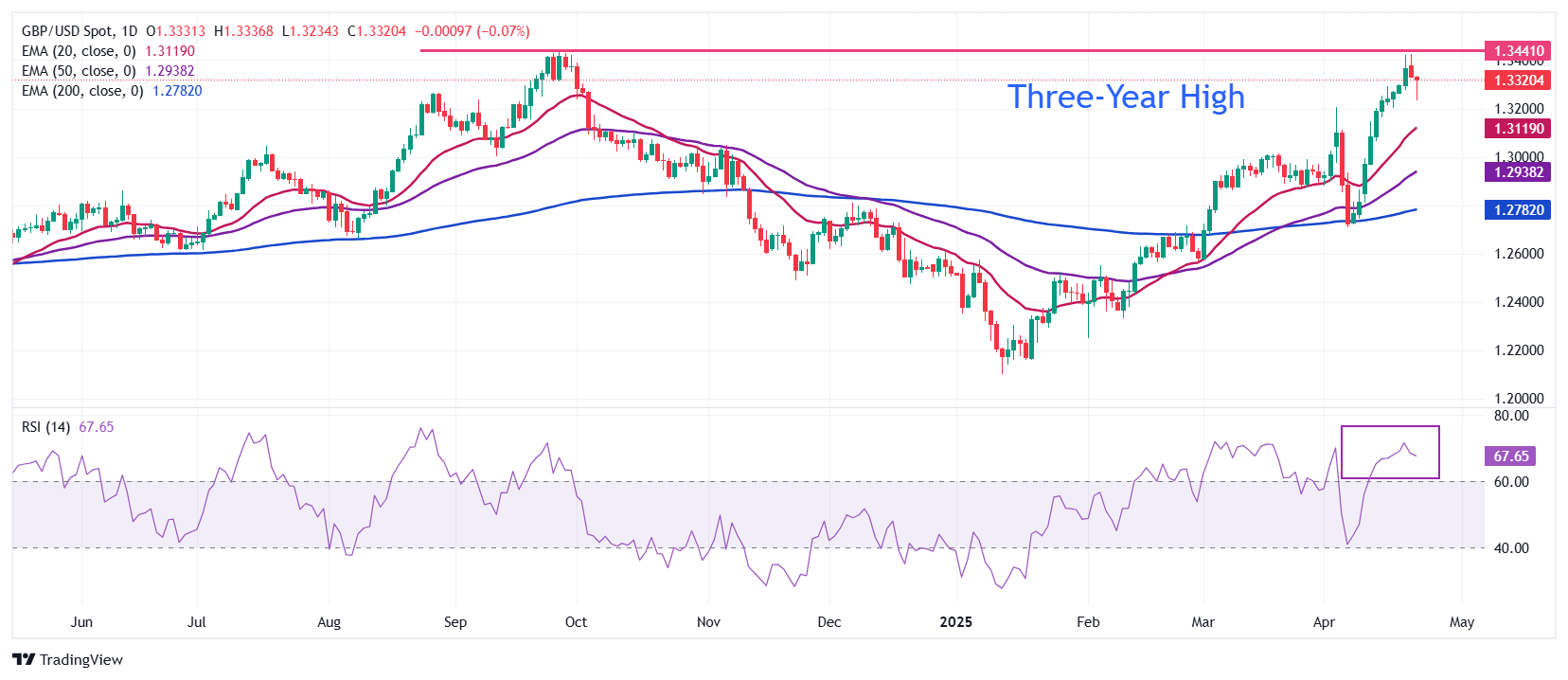- The Pound Sterling trades lower against the US Dollar as Trump pushes back fears of Fed Powell’s removal and intensified global trade war.
- Trump is confident of closing bilateral deals with various nations soon.
- Investors await the preliminary UK/US PMI data for April.
The Pound Sterling (GBP) recovers some of its initial losses against the US Dollar (USD) in Wednesday’s European session, still trading lower in the day around 1.3300. The GBP/USD pair pares some intraday losses as the US Dollar (USD) retraces after a sharp upside move on Wednesday. The US Dollar Index (DXY), which tracks the Greenback’s value against six major currencies, corrects to near 99.20 from the earlier high of 99.88.
Investors brace for more recovery in the US Dollar on optimism over de-escalation in the United States (US)-China trade war and diminishing fears of President Donald Trump sacking Federal Reserve (Fed) Chair Jerome Powell for not lowering interest rates.
While addressing reporters at the Oval Office on Tuesday, Donald Trump highlighted a “sharp reduction in trade deficits” and “rising revenue” generated from the imposition of tariffs on foreign cars, aluminium, and steel. Trump expressed confidence that his administration is negotiating deals with several countries, which will be effective soon. On the current situation with China, Trump commented that “discussions with Beijing are going well”. The President added that he thinks “they will reach a deal”. Trump further added that tariffs on China would not be as high as “145%, but they wouldn’t be zero”.
Moreover, President Trump pushed back fears of removing Jerome Powell despite criticizing him for not supporting monetary policy expansion. “The press runs away with things. No, I have no intention of firing him. I would like to see him be a little more active in terms of his idea to lower interest rates.”
In the last few trading sessions, investors were punishing the US Dollar and US assets due to Trump’s assault on the Fed’s independence and ever-changing headlines on trade policies. Market participants started doubting the safe-haven status of the US Dollar.
In North American trading hours, investors will focus on the flash US S&P Global Purchasing Managers’ Index (PMI) data for April.
Daily digest market movers: Pound Sterling declines ahead of flash UK/US PMI data
- The Pound Sterling trades lower against most of its peers on Wednesday ahead of the preliminary S&P Global/CIPS PMI data for April, which will be published at 08:30 GMT. The PMI report is expected to show that the overall business activity grew at a moderate pace. The Composite PMI is expected to come in at 50.4, down from 51.5 in March due to weakness in both the manufacturing and services sectors.
- According to estimates, the Manufacturing PMI is expected to decline to 44.0 from the prior release of 44.9. At the same time, the Services PMI is expected to expand at a moderate pace of 51.3 from 52.5 in March. Business owners are expected to have underutilized their capacity in April due to fears of potential global economic turmoil in the face of uncertainty over tariff policies by US President Trump.
- This week, investors will also focus on the United Kingdom (UK) Retail Sales data for March, which will be released on Friday. The Retail Sales data, a key measure of consumer spending, is estimated to have declined by 0.4% month-on-month after rising by 1% in February.
- On the monetary policy front, market participants are confident that the Bank of England (BoE) could reduce interest rates in the May policy meeting. Traders have become increasingly confident about an interest rate reduction next month due to slower-than-expected growth in the Consumer Price Index (CPI) data for March and the uncertainty over the global economic outlook.
- Additionally, slowing UK wage growth is also paving the way for further monetary policy easing. Britain’s human resources data firm Brightmine showed on Tuesday that pay awards rose by 3% for the fourth rolling quarter in a row, which is the slowest increase since December 2021.
Technical Analysis: Pound Sterling holds key EMAs

The Pound Sterling corrects to near 1.3300 against the US Dollar during European trading hours on Wednesday after visiting the three-year high around 1.3430 the previous day. However, the outlook of the pair remains firm as all short-to-long Exponential Moving Averages (EMAs) are sloping higher.
The 14-day Relative Strength Index (RSI) cools down slightly after reaching overbought levels above 70.00. This indicates a mild correction in the pair after a strong rally, but the upside trend is intact.
On the upside, the psychological level of 1.3500 will be a key hurdle for the pair. Looking down, the April 3 high around 1.3200 will act as a major support area.
Pound Sterling FAQs
The Pound Sterling (GBP) is the oldest currency in the world (886 AD) and the official currency of the United Kingdom. It is the fourth most traded unit for foreign exchange (FX) in the world, accounting for 12% of all transactions, averaging $630 billion a day, according to 2022 data. Its key trading pairs are GBP/USD, also known as ‘Cable’, which accounts for 11% of FX, GBP/JPY, or the ‘Dragon’ as it is known by traders (3%), and EUR/GBP (2%). The Pound Sterling is issued by the Bank of England (BoE).
The single most important factor influencing the value of the Pound Sterling is monetary policy decided by the Bank of England. The BoE bases its decisions on whether it has achieved its primary goal of “price stability” – a steady inflation rate of around 2%. Its primary tool for achieving this is the adjustment of interest rates. When inflation is too high, the BoE will try to rein it in by raising interest rates, making it more expensive for people and businesses to access credit. This is generally positive for GBP, as higher interest rates make the UK a more attractive place for global investors to park their money. When inflation falls too low it is a sign economic growth is slowing. In this scenario, the BoE will consider lowering interest rates to cheapen credit so businesses will borrow more to invest in growth-generating projects.
Data releases gauge the health of the economy and can impact the value of the Pound Sterling. Indicators such as GDP, Manufacturing and Services PMIs, and employment can all influence the direction of the GBP. A strong economy is good for Sterling. Not only does it attract more foreign investment but it may encourage the BoE to put up interest rates, which will directly strengthen GBP. Otherwise, if economic data is weak, the Pound Sterling is likely to fall.
Another significant data release for the Pound Sterling is the Trade Balance. This indicator measures the difference between what a country earns from its exports and what it spends on imports over a given period. If a country produces highly sought-after exports, its currency will benefit purely from the extra demand created from foreign buyers seeking to purchase these goods. Therefore, a positive net Trade Balance strengthens a currency and vice versa for a negative balance.
BRANDED CONTENT
Choosing a broker that aligns with your trading needs can significantly impact performance. Our list of the best regulated brokers highlights the best options for seamless and cost-effective trading.







